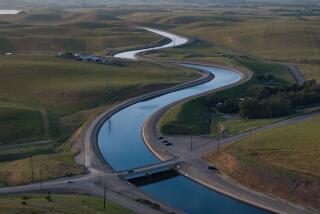Silicon Valley is roiled by feds ordering draining of reservoir to reduce quake risks
- Share via
MENLO PARK — A federal order to drain Silicon Valley’s largest drinking water reservoir has thrown the region into disarray, with multiple agencies pointing fingers at each other and some local leaders fearful their cities could run out of water, not this summer but the following one.
On Monday, officials from the Federal Energy Regulatory Commission sent a letter to the Santa Clara Valley Water District, a government agency based in San Jose, ordering them to drain Anderson Reservoir and chiding them for moving too slowly with retrofits for the reservoir’s dam, which sits atop a major earthquake fault.
“This is deeply concerning,” said Rich Constantine, the mayor of Morgan Hill, where the reservoir is located. “This water is critical for people in the area. And as we seem to be on the cusp of a drought, this move seems drastic and dramatic.”
The reservoir, located between the cities of San Jose and Morgan Hill, holds 89,278 acre-feet of water when full. That’s more than the water district’s other nine reservoirs combined. It is currently at just 29%, following the driest February on record, down from 40% — the level required during winter months to avoid spillover.
Recent studies show the Calaveras fault, which runs underneath the reservoir, could generate a large magnitude earthquake. A 6.6 magnitude temblor underneath the reservoir, or a 7.2 magnitude quake one mile away, could damage the 70-year old dam — which is not built on bedrock, but on sand and gravel — causing it to “slump,” potentially allowing a major spillover event into the Santa Clara Valley and up to San Francisco Bay.
“A collapse of the Anderson reservoir could potentially kill tens of thousands of people from San Francisco Bay all the way to Monterey,” said Rep. Zoe Lofgren (D-San Jose), who supports the move by FERC.
“I’ve lived in the Bay Area my whole life,” she said. And while “we don’t know when the big one will come, we do know it’s coming.”
In its Feb. 24 letter, David Capka, director of FERC’s Dam Safety and Inspections division, wrote that the commission deemed the district’s 40% drawdown inadequate, and he ordered it to drain the reservoir to “deadpool” starting Oct. 1, the beginning of the rainy season.
“Until full remediation is completed, the dam safety risk at this project is unacceptably high,” wrote Capka, in his letter to the district. “Your actions to date do not demonstrate an appropriate sense of urgency regarding the interim conditions at the project.”
Three years ago, the spillway of the Oroville Dam in Butte County crumbled during heavy winter storms. Nearly 200,000 people were evacuated. Since then, both FERC and the State Department of Water Resources have become more vigilant regarding dam safety.

Constantine, whose city would feel the brunt of a spillover event — a dramatic video released by the water district shows the city becoming inundated by a surge of water within just a few minutes of a major quake — said he was perplexed and frustrated by the move.
“First of all, the district has already reduced risk by bringing levels down ... It’s the feds who have dragged their feet or asked for more,” he said, referring to requests by the National Marine Fisheries Service for environmental studies of a dam retrofit.
Several protected species and vulnerable ecosystems live within or alongside Coyote Creek, a rivulet that runs 30 miles downstream from the reservoir, through San Jose and into San Francisco Bay. Any disruption to the availability of water from the reservoir could impact those species.
“I can’t imagine draining the reservoir” and drying out the creek, where steelhead trout and other riparian species live, was the agency’s end goal, he said. “But I don’t know. Maybe this drastic move will kick-start everybody into action.”
Michael Milstein, federal fisheries spokesman, took issue with Constantine’s characterization.
“We have made clear to Valley Water and to local officials including Mayor Constantine that public safety takes priority at Anderson Reservoir,” he said, adding that officials with federal agency have made it clear “we would not impose any requirements that would stand in the way of work necessary to make the dam and reservoir safe.”
“While we are of course interested in steelhead recovery, public safety takes priority,” he said.
Lofgren, who represents the district, agreed, adding that disruption to the creek was inevitable. She said the drastic course taken by FERC will ensure that the retrofits are made sooner rather than later, potentially saving tens of thousands of lives should a major quake hit the region.
Because the reservoir is already low, she noted, the impact on drinking water availability is likely to be minimal.
Nina Hawk, the district’s chief operating officer of water utility, underscored that point, noting that 40% of the area’s water is imported, and 55% comes from groundwater.
“The aquifers are in healthy condition,” she said, noting the absence of water from Anderson is unlikely to affect available water for the duration of the year.
Constantine, however, questioned what could happen if this dry year is followed by a second dry winter, or a third.
“Our groundwater is replenished by water from that reservoir,” he said. “If there’s no water coming into replenish, how long is that going to last?”
More to Read
Sign up for Essential California
The most important California stories and recommendations in your inbox every morning.
You may occasionally receive promotional content from the Los Angeles Times.











